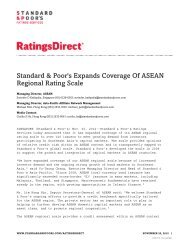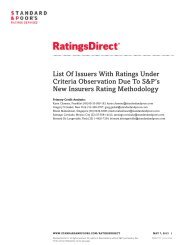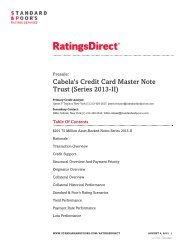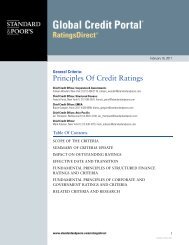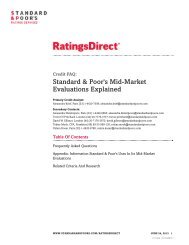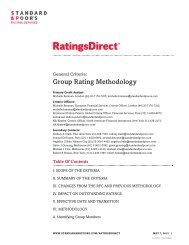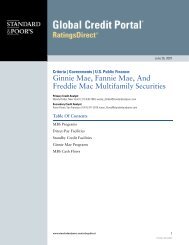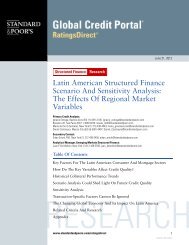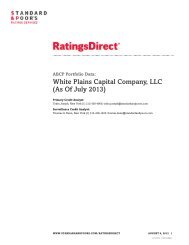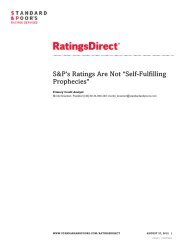What May Cause Insurance Companies To Fail ... - Standard & Poor's
What May Cause Insurance Companies To Fail ... - Standard & Poor's
What May Cause Insurance Companies To Fail ... - Standard & Poor's
You also want an ePaper? Increase the reach of your titles
YUMPU automatically turns print PDFs into web optimized ePapers that Google loves.
<strong>What</strong> <strong>May</strong> <strong>Cause</strong> <strong>Insurance</strong> <strong>Companies</strong> <strong>To</strong> <strong>Fail</strong>--And How This Influences Our CriteriaThe case of JapanThe collapse of Nissan Mutual Life, Japan's 16th-largest life insurer, in April 1997, showed that Japanese life insurancecompanies could fail. This bankruptcy, the first in the industry's history, triggered a loss of confidence, resulting in asharp increase in surrenders for most insurers in the subsequent 12 months. Because no regulatory or industry schemeexisted to protect policyholders, suspicions about the credibility of life insurers spread rapidly, particularly amongordinary individual policyholders. Subsequently, several then-rated insurers, including Chiyoda Mutual Life <strong>Insurance</strong>Co., Kyoei Life <strong>Insurance</strong> Co., and <strong>To</strong>ho Mutual Life <strong>Insurance</strong> Co., voluntarily entered rehabilitation proceedings orclosed their insurance business under regulatory order. These failures were primarily the result of industry-wideafflictions. Japanese life business was being written at negative spreads, so insurers were taking on investment risk tocompensate, creating higher risk profiles. High payout rates (typically of greater than 95%) were common and wereused to support the mutual business models. However, they left insurers with thin balance sheets and inadequatecapital resources.Criteria ReponsesOur various criteria enhancements since these events aim to address the negative effects of market pricing andreserving dynamics in several ways. First is the IICRA, which takes account of industry underwriting standards andwhich could be adjusted to reflect poor market operating conditions. Our entity-specific assessments also addressnegative trends that affect only a segment of the market. As appropriate, our assessment of companies concentrated ina market sector that is experiencing tough competition or narrow-margin prices would likely include a negativebusiness risk profile (BRP) adjustment to reflect the risks associated with the competitive position, as well as a negativescore for additional sources of capital volatility. This would weigh on the BRP and the financial risk profile (FRP), andtherefore on the ratings.The IICRA can also capture contributors to insurer distress such as distortionary legal restrictions on investments,government-imposed controls, and problems with the regulatory framework.Catastrophe-Fueled <strong>Fail</strong>uresAlthough certain insurance companies are exposed to specific catastrophes, such as floods and hurricanes, we haveseen few failures due to the occurrence of such events. That said, ultimate losses may have been greater than insurershad anticipated.One insurer that came near to failure following the terrorist attack on the World Trade Center (WTC) in 2001, wasJapanese Taisei Fire & Marine <strong>Insurance</strong> Co. Ltd. The losses incurred exceeded Taisei Fire's capital such that itmerged with Sompo Japan <strong>Insurance</strong> Inc. soon after, in December 2002. However, in our view, the distress at TaiseiFire cannot be solely attributed to the size of its exposure to a specific catastrophic event, but rather to the riskmanagement issues that allowed such an exposure to build.New Zealand's Christchurch and Canterbury region earthquakes in September 2010 and February 2011 were againunexpected, and therefore the effects on insurers would have been difficult to anticipate. The region is not consideredWWW.STANDARDANDPOORS.COM/RATINGSDIRECT JUNE 13, 2013 101144346 | 300323561




